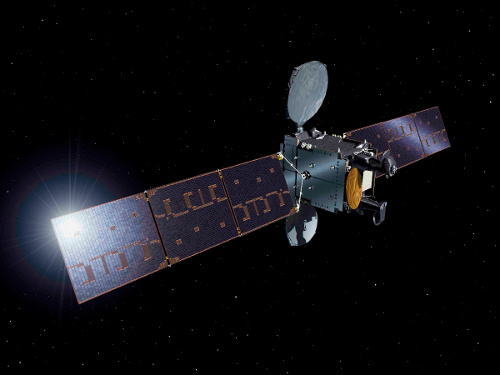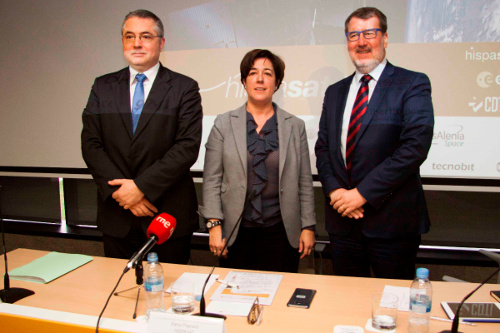Hispasat 36W-1 satellite due for orbit on January 27
Monday, January 16th, 2017
Hispasat launches it most innovative satellite yet: the H36W-1
- Today the operator presented the Hispasat 36W-1, which it developed in collaboration with the ESA and which will be put into orbit in January.
- Built on the new SmallGEO platform, Hispasat 36W-1 has a regenerative payload which will provide greater flexibility to the satellite.
- The new HISPASAT satellite was developed with broad participation from the Spanish space industry, financed through Spain’s contribution to the European Space Agency.
- The Hispasat 36W-1 has 20 Ku-band transponders and additional capacity for up to 3 Ka-band transponders and will open the operator’s orbital position located at 36° West.
MADRID — Today Spanish satellite and telecommunications operator HISPASAT presented their Hispasat 36W-1 satellite (H36W-1) at their headquarters in Madrid. The satellite will be put into orbit on January 27 using a Soyuz launch vehicle and will be launched from the European Spaceport of Kourou in French Guiana. Elena Pisonero, president of HISPASAT, Juan Carlos Cortés, director of International Programmes at the Centre for the Development of Industrial Technology (Centro para el Desarrollo Tecnológico Industrial – CDTI), and Xavier Lobao, head of Future Telecommunications Projects at the European Space Agency (ESA), all attended the presentation.

Hispasat 36W-1, which is currently at Kourou, has 20 Ku-band transponders and additional capacity for up to 3 Ka-band transponders over the Iberian Peninsula and the Canary Islands. It will open the orbital position located at 36º West, providing HISPASAT’s fleet with new and optimised coverage over South America, Europe and the Canary Islands. It is also the first satellite built on the SmallGEO platform, which was jointly developed by the ESA and the German manufacturer OHB System AG. The design of this platform allows for a substantial reduction in the mass of the satellite thanks to the use of electric propulsion throughout its entire useful life, thereby reducing launching costs and meeting the highest requirements for telecommunications services. Moreover, Hispasat 36W-1 features the innovative RedSAT regenerative payload, made up of a processor and an antenna that actively receives reconfigurable beams.
A push for flexibility in orbit
Both elements are combined to provide HISPASAT with greater flexibility for their services. On the one hand, the processor regenerates the signal received to transmit it cleanly and noise-free to Earth, thus meaning that the quality of the signal that reaches our clients is much higher than that which is obtained through traditional satellites. Furthermore, part of the process which is usually done on the ground will be done on board the Hispasat 36W-1, considerably simplifying the structure of the network, allowing the size and power of the user terminals to be optimised and simplifying links that would normally require a double hop, thereby reducing latency and maximising the space segment. The on-board process therefore constitutes a further step in the evolution of satellite communications.
Moreover, the DRA-ELSA (Direct Radiating Array – Electronically Steerable Antenna) used on the satellite allows the beams received to be reoriented, the position of which is electronically controlled from Earth and can be changed at any moment so that the satellite can be adapted to the new needs of clients throughout its entire useful life. Summing up, the use of an innovative payload such as RedSAT improves the quality of the services provided to Hispasat’s clients and will allow the company to adapt to changes in the market.
The new HISPASAT satellite was developed with the broad participation of the Spanish space industry, financed through Spain’s contribution to the European Space Agency. Specifically, the project’s key innovative developments were carried out by Spanish industry: Airbus Defence and Space España built the active ELSA antenna, and Thales Alenia Space España was behind the RedSAT processor. Furthermore, other Spanish companies from the sector participated in providing a variety of systems.

In the words of Elena Pisonero, president of HISPASAT: “With the development of this new satellite, HISPASAT is now at the forefront of initiatives for the use of payloads in innovative communications, through which it will be possible to offer the latest in communications services. We will provide support to our clients in the area of video contribution services, backhaul celular in Latin America and we will also provide more efficient broadband services thanks to the Ka-band capacity incorporated in the satellite”.
According to Juan Carlos Cortés: “The CDTI highly values the important milestone reached through the launch of this satellite and the broad participation of the Spanish industry, led by the driving force of the operator HISPASAT. The government has made a strong investment in this project through the European Space Agency (ESA) in support of the participating companies, which we hope will lead to a higher position for these companies in the value chain, an expansion of their product portfolio and an increase in their exports”.
Xavier Lobao added: “The PPP model, or public–private partnership, implemented by the ESA in the ARTES telecommunications programme maximises the benefits of introducing technological innovation into the area of satellite telecommunications for all participants. On the one hand, it allows the operator’s level of acceptable innovation to be increased by sharing the risks with the public sector. On the other hand, for companies that develop technology, it provides a faster pace at which products can be introduced to the market and facilitates a first in-orbit demonstration and a commercial and operational reference. Lastly, it increases funding for administrative bodies thanks to private co-financing and ensures that technological development meets specific needs and is sufficiently developed to be marketed”.
Latest News
- Barb to start reporting TV-set viewing of YouTube channels
- SAT FILM selects multi-DRM from CryptoGuard
- Qvest and ARABSAT to launch OTT streaming platform
- ArabyAds & LG Ad Solutions partner with TVekstra in Turkey
- Freeview NZ satellite TV service to move to Koreasat 6
- Comscore expands YouTube CTV measurement internationally
